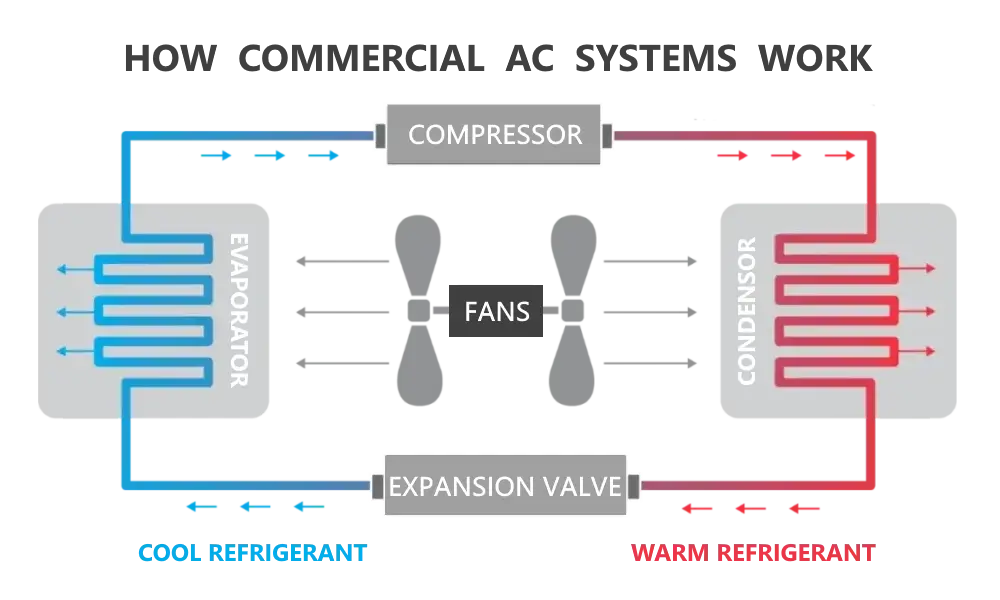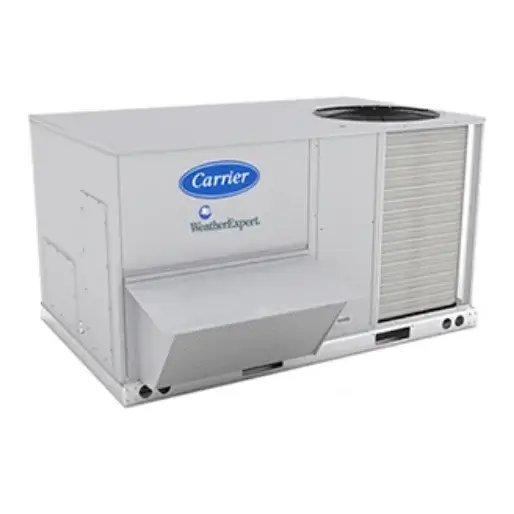AskHVACPro Makes Maintaining Your Commercial Rooftop Cooling System a Breeze
Our commercial cooling systems provide businesses with industry-leading air conditioning solutions. AskHVACPro commercial HVAC repair, maintenance & installation upgrades are part of our service.
Why Upgrade Your Commercial Cooling System?
Today’s cooling technology is better for business
Your customers love summer until the air conditioner in your office or store breaks down. An unreliable old AC is just bad for business, from discomfort and costly repairs to higher energy costs and new environmental laws. Fortunately, today’s cooling technology is better for your building, the environment and your bottom line:
- Better Refrigerant – Most older ACs contain R22, an ozone-depleting refrigerant. Today’s systems contain R410a, an environmentally-friendly refrigerant that absorbs and releases heat while reducing the risk of your system overheating1.
- Better Energy Efficiency – Seasonal Energy Efficiency Ratio, or SEER, is the maximum cooling efficiency of an AC. While systems 10-15 years old have a rating of 9 or 10, today’s ratings range from 13 to 25+.2
- Better Fans – In the past, ACs only had one speed: maximum, resulting in overworked equipment. Variable speed technology runs on lower speeds on cooler days and higher rates on hotter days, using less energy and making less noise.
- Better Compressors – Older ACs typically have a single-stage compressor that can only operate at full capacity, making a lot of noise and using a lot of electricity. Newer systems have dual-stage compressors that can run at a lower capacity when needed.
- Better Ductless Heating & Cooling – Installing ductwork can be an expensive challenge. Ductless mini-splits are a great option for cooling spaces without ducts, with non-invasive installation and small air handlers in each room.
How Commercial AC Works
How Air Conditioners work

- Air Conditioners remove heat and humidity from the indoor air and return cooled air into the indoor space.
- A chemical refrigerant moves through the four main mechanical components of your equipment; the compressor, condenser coil, expansion valve and evaporator. Working together, they quickly convert the refrigerant from gas to liquid and back into gas.
- The compressor raises the pressure and temperature of the refrigerant gas, sending it to the condenser coil where it is converted to a liquid.
- The refrigerant then travels back indoors and enters the evaporator coil, where the liquid refrigerant evaporates, cooling the indoor air.
- A fan blows indoor air across the cold evaporator coil, where the heat inside is absorbed into the refrigerant.
- Cooled air is then circulated throughout the space, while the heated evaporated gas is sent back outside to the compressor.
- The heat is then released into the outdoor air as the refrigerant returns to a liquid state.
- This cycle continues until the building has reached the desired temperature.
The AC Evolution
How cooling systems have evolved over the years
1926
The first Rooftop AC Unit
Carrier successfully installs multi-story cooling in the T.W. Patterson Building in Fresno, California. It had centrifugal chiller equipment in the basement, and air conditioning on the roof.4
1973
Mini Split Ductless Systems are invented
Japanese company Daikin invents the first Mini Split Ductless System,5 known today as the perfect solution for buildings with no ductwork.
1982
VRF (Variable Refrigerant Flow) systems are invented
Also invented by Daikin, VRFs are a type of Mini Split Ductless System. Highly efficient, they offer energy savings of up to 55% over comparable equipment.5
1992
What is SEER?
Seasonal Energy Efficiency Ratio (SEER) was introduced in 1992 as a measurement of cooling efficiency. SEER is a measurement of cooling efficiency for electric air-cooled heat pumps and air conditioning units as defined by the Air Conditioning, Heating, and Refrigeration Institute (AHRI). A SEER ratio is calculated over an entire cooling season using a constant indoor temperature and a variety of outdoor temperatures ranging from 60 degrees to 100 plus. There’s no magic SEER number although, anything over 13 is great. Because if you have an old 8 SEER system and replace it with a 16 SEER unit, you could significantly reduce the energy consumption used for cooling your building.
Benefits of a High SEER Rating
Higher energy efficiency
The higher the SEER of your air conditioning system, the more efficient it is.
Greater indoor comfort
Higher SEER units often have two components that provide greater indoor comfort: a two-stage or variable-speed compressor and a variable-speed blower.
Less expensive Installation
The components of the RTU HVAC are ideal, and they are always pre-installed. As a result, installing the entire system can be simple and inexpensive.
The tax credit, rebates
Tax credits and manufacturer’s rebates can bring down the cost of a high SEER system
Environmental Impact
Is your AC over 15 years old? It’s time to upgrade
- Most AC units older than 15 years use R22, a harmful ozone-depleting refrigerant.7
- Once released into the atmosphere, R22 causes irreversible damage to the environment.3
- R22 has slowly been phased out globally, with a complete ban going into effect January 1, 2020.7
- Once illegal, R22 can no longer be manufactured or imported into the country.7
Don’t wait until an irreparable breakdown – we’re here to help
- If your AC system requires R22 and breaks down after January 1st, it can no longer be repaired by adding refrigerant to the system.7
- AskHVACPro offers cost-effective and energy-efficient alternatives to typical AC units.
- From packaged Rooftop Units with variable speed for efficient and precise temperature control, to ductless split systems like Variable Refrigerant Flow, with non-intrusive installation and zone control heating and cooling, we have your solution.
Featured Products
Whatever your business, we have your cooling system

Carrier WeatherExpert 48
- Available with 3 to 23-ton cooling capabilities
- Ultra-high efficiency model with SEERs up to 17.5
- Multi-stage compressors and VFDs for better control and energy savings8
- Recommended for: Restaurants, Multi-Residential buildings, Retail spaces

Daikin VRV IV
- Available with 6 to 34-ton cooling capabilities
- Heats and cools simultaneously
- Integrated Energy Efficiency Ratio (IEER) up to 28
- Design flexibility with piping lengths up to 3,280 ft total and 100 ft. vertical separation between indoor units9
- Recommended for: Multi-Residential buildings, Large Commercial spaces
Why Choose AskHVACpro?
With all the expensive business-related decisions you need to make, upgrading your mechanical systems shouldn’t be one of them. Free up capital to invest in your business with the AskHVACPro AdvantageTM rental program. Upgrade your equipment for $0 upfront* and you could also benefit from:
Design & Installation
- Industry leading products, featuring brands like Armstrong Air, GSW and Rinnai
- NEW energy-efficient equipment to offset your carbon footprint
- Quality installations done right the first time
Service & Maintainance
- HVAC maintenance to keep your equipment safe and efficient
- Performed by fully-licensed and insured technicians
- Priority service through our 24/7/365 call centre
Value Creation
- Utility rebates application support on eligible equipment
- Invest in other business improvement projects
- No-cost transfer on sale of property
AC Repair Locations
Find an AC repair specialist with AskHVACPros near you
Areas we serve in Wake County:
- Apex, NC
- Cary, NC
- Fuquay Varina, NC
- Holly Springs, NC
- Knightdale, NC
- Morrisville, NC
- New Hill, NC
- Raleigh, NC
- Rolesville, NC
- Wake Forest, NC
- Wendell, NC
- Willow Spring, NC
